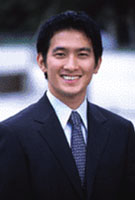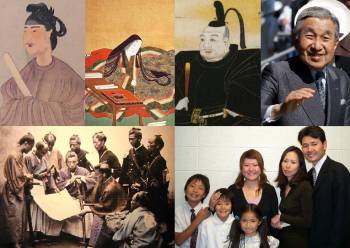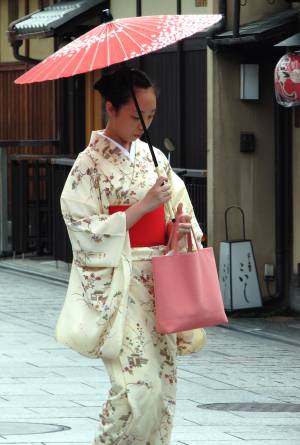Delicious and healthy Japanese foods and ingredients are getting very popular around the world. In this program we explore the enchantment of Japan's dietary culture.
Delicious NIPPON is one of the programs of The Food of Japan Campaign in association with Japan's Ministry of Agriculture, Forestry and Fisheries.
Each of the programs were broadcast worldwide via NHK World/JIB-tv (Japan International Broadcasting Inc.) in an effort to allow people from various countries to develop a wider comprehension and deeper familiarity with Japanese agricultural and marine products while further promoting the enhancement of export opportunities.

Presenter: Judy Ongg

Instructor: Naoyuki Yanagihara

Reporter: John O'Connor

Reporter: Nicholas Pettas
Discover NIPPON
The Japanese name for Japan is Nippon, which is used for most official purposes, including on Japanese yen, postage stamps, and for many international sporting events. Nippon means "sun-origin" and are often translated as "Land of the Rising Sun".
Japan is an archipelago of 6,852 islands. The four largest islands are Honshū, Hokkaidō, Kyūshū and Shikoku, together accounting for 97% of Japan's land area. Japan has the world's tenth-largest population, with over 127 million people. The Greater Tokyo Area, which includes the de facto capital city of Tokyo and several surrounding prefectures, is the largest metropolitan area in the world, with over 30 million residents.
Archaeological research indicates that people lived in Japan as early as the Upper Paleolithic period. The first written mention of Japan is in Chinese history texts from the 1st century AD. Influence from other nations followed by long periods of isolation has characterized Japan's history.
In the late 19th and early 20th centuries victory in the First Sino-Japanese War, the Russo-Japanese War, and World War I allowed Japan to expand its empire during a period of increasing militarism. The Second Sino-Japanese War of 1937 expanded into part of World War II, which brought to an end in 1945 by the atomic bombings of Hiroshima and Nagasaki.
Since adopting its revised constitution in 1947, Japan has maintained a unitary constitutional monarchy with an emperor and an elected parliament called the Diet.
Economy:
As of 2011, Japan is the third largest national economy in the world, after the United States and China, in terms of nominal GDP, and the fourth largest national economy in the world, after the United States, China and India in terms of purchasing power parity. It is also the world's fourth largest exporter and fourth largest importer.
A mountainous, volcanic island country, Japan has inadequate natural resources to support its growing economy and large population. Because of political decisions on local, prefectural, and nation levels, Japan decided not to exploit its forest resources for economic gain. Deposits of gold, magnesium, and silver meet current industrial demands, but Japan is dependent on foreign sources for many of the minerals essential to modern industry. Iron ore, copper, bauxite, and alumina must be imported, as well as many forest products.
The service sector accounts for three quarters of the gross domestic product. Japan has a large industrial capacity, and is home to some of the largest and most technologically advanced producers of motor vehicles, electronics, machine tools, steel and nonferrous metals, ships, chemical substances, textiles, and processed foods. Agricultural businesses in Japan cultivate 13% of Japan's land, and Japan accounts for nearly 15% of the global fish catch, second only to China.
Japan ranks 12th of 178 countries in the 2008 Ease of Doing Business Index and has one of the smallest tax revenues of the developed world. The Japanese variant of capitalism has many distinct features: keiretsu enterprises are influential, and lifetime employment and seniority-based career advancement are relatively common in the Japanese work environment. Some of the largest enterprises in Japan include Toyota, Nintendo, NTT DoCoMo, Canon, Honda, Takeda Pharmaceutical, Sony, Panasonic, Toshiba, Sharp, Nippon Steel, Nippon Oil, and Seven & I Holdings Co. It has some of the world's largest banks, and the Tokyo Stock Exchange (known for its Nikkei 225 and Topix indices) stands as the second largest in the world by market capitalization. Japan is home to 326 companies from the Forbes Global 2000 or 16.3% (as of 2006).
As of 2010, Japan's labor force consisted of some 65.9 million workers. Japan has a low unemployment rate of around four percent. Almost one in six Japanese, or 20 million people, lived in poverty in 2007. Housing in Japan is characterized by limited land supply in urban areas.
Although Japan has officially renounced its right to declare war, it maintains a modern military force in self-defense and peacekeeping roles. After Singapore, Japan has the lowest homicide (including attempted homicide) rate in the world.
Demographics:
 According to both UN and WHO estimates, Japan has the longest life expectancy of any country in the world. According to the UN, it has the third lowest infant mortality rate. However, Japan suffers from a high suicide rate. In 2009, the number of suicides exceeded 30,000 for the twelfth straight year. Suicide is the leading cause of death for people under 30.
According to both UN and WHO estimates, Japan has the longest life expectancy of any country in the world. According to the UN, it has the third lowest infant mortality rate. However, Japan suffers from a high suicide rate. In 2009, the number of suicides exceeded 30,000 for the twelfth straight year. Suicide is the leading cause of death for people under 30.
The Japanese population is rapidly aging as a result of a post–World War II baby boom followed by a decrease in birth rates. In 2009, about 22.7 percent of the population was over 65, by 2050 almost 40 percent of the population will be aged 65 and over, as projected in December 2006. The changes in demographic structure have created a number of social issues, particularly a potential decline in workforce population and increase in the cost of social security benefits like the public pension plan. A growing number of younger Japanese are preferring not to marry or have families. Japan's population is expected to drop to 95 million by 2050.
Japanese society is linguistically and culturally homogeneous with small populations of foreign workers. Japan has a steady flow of about 15,000 immigrants per year. Zainichi Koreans, Zainichi Chinese, Filipinos, Japanese Brazilians, and Japanese Peruvians are among the small minority groups in Japan. In 2003, there were about 136,000 Western expatriates. The most dominant native ethnic group is the Yamato people; primary minority groups include the indigenous Ainu and Ryukyuan peoples, as well as social minority groups like the burakumin.
Upper estimates suggest that 84%–96% of the Japanese population subscribe to Buddhism or Shinto. However, these estimates are based on people affiliated with a temple, rather than the number of true believers. Other studies have suggested that only 30% of the population identify themselves as belonging to a religion. Nevertheless the level of participation remains high, especially during festivals and occasions such as the first shrine visit of the New Year. Taoism and Confucianism from China have also influenced Japanese beliefs and customs. Fewer than one percent of Japanese are Christian. In addition, since the mid-19th century numerous new religious movements have emerged in Japan.
Japanese Culture:
 Japanese culture has evolved greatly from its origins. Contemporary culture combines influences from Asia, Europe and North America. Traditional Japanese arts include crafts such as ceramics, textiles, lacquerware, swords and dolls; performances of bunraku, kabuki, noh, dance, and rakugo; and other practices, the tea ceremony, ikebana, martial arts, calligraphy, origami, onsen, Geisha and games. Japan has a developed system for the protection and promotion of both tangible and intangible Cultural Properties and National Treasures. Sixteen sites have been inscribed on the UNESCO World Heritage List.
Japanese culture has evolved greatly from its origins. Contemporary culture combines influences from Asia, Europe and North America. Traditional Japanese arts include crafts such as ceramics, textiles, lacquerware, swords and dolls; performances of bunraku, kabuki, noh, dance, and rakugo; and other practices, the tea ceremony, ikebana, martial arts, calligraphy, origami, onsen, Geisha and games. Japan has a developed system for the protection and promotion of both tangible and intangible Cultural Properties and National Treasures. Sixteen sites have been inscribed on the UNESCO World Heritage List.
Japanese popular culture not only reflects the attitudes and concerns of the present but also provides a link to the past. Japanese cinema, cuisine, television programs, manga, and music all developed from older artistic and literary traditions, and many of their themes and styles of presentation can be traced to traditional art forms. Contemporary forms of popular culture, much like the traditional forms, provide not only entertainment but also an escape for the contemporary Japanese from the problems of an industrial world.
Traditionally, sumo is considered Japan's national sport. Japanese martial arts such as judo, karate and kendo are also widely practiced and enjoyed by spectators in the country. After the Meiji Restoration, many Western sports were introduced in Japan and began to spread through the education system. The Japanese professional baseball league was established in 1936. Today baseball is the most popular spectator sport in the country. Since the establishment of the Japan Professional Football League in 1992, association football has also gained a wide following. Japan has one of the most successful football teams in Asia, winning the Asian Cup four times. Also, Japan recently won the FIFA Women's World Cup in 2011. Golf is also popular in Japan, as are forms of auto racing like the Super GT series and Formula Nippon.
Tourism:
Tourism in Japan attracted 8.3 million foreign visitors in 2008. Neighboring South Korea is Japan's most important source of foreign tourists, with arrivals of 2.4 million in 2010 which made up 27% of total number of tourists visited Japan. Japan has 16 World Heritage Sites, including Himeji Castle and Historic Monuments of Ancient Kyoto (Kyoto, Uji and Otsu Cities). Kyoto receives over 30 million tourists annually. Foreigners also visit Tokyo and Nara, Mount Fuji, ski resorts such as Niseko in Hokkaidō, Okinawa, ride the shinkansen and take advantage of Japan's hotel and hotspring network.
Here's a Sneak Preview of the beautiful, high-quality and delicious Japanese cuisine and ingredients you'll learn about in the following 8 exciting episodes of Delicious NIPPON.
Episodes:
 |
JAPANESE CUISINE: We introduce you to the well-balanced Japanese menu and meal style. |
 |
JAPANESE RICE: The pursuit of delicious rice to this day remains an ongoing national passion. |
 |
SEAFOOD: The Japanese are masters at unlocking the flavor of the ocean bounty. |
 |
VEGETABLES: Japan has a variety of unique vegetables. We take a look at some delicious & healthy Japanese vegetables. |
 |
FRUIT: With its clearly defined seasons and dedicated farmers, Japan is home to many varieties of sweet fruit. |
 |
GIFTS FROM THE FOREST: Japanese have accumulated knowledge of producing high quality mushrooms and charcoal. |
 |
JAPANESE BEEF: Discover the secrets of the great taste of Japan's Wagyu, now an internationally recognized brand of beef. |
 |
JAPANESE GREEN TEA: Japan is extremely proud of its traditional drink. For generations, it has been indispensable to their way of life. |
Contact Us | Shop | Sitemap | Join Our Team | Investors | Advertise | Web Design Services
Community | Foodies' Choice | Meetup Groups | Chat | Blogs | Forums | Submit Your Site | Resources

